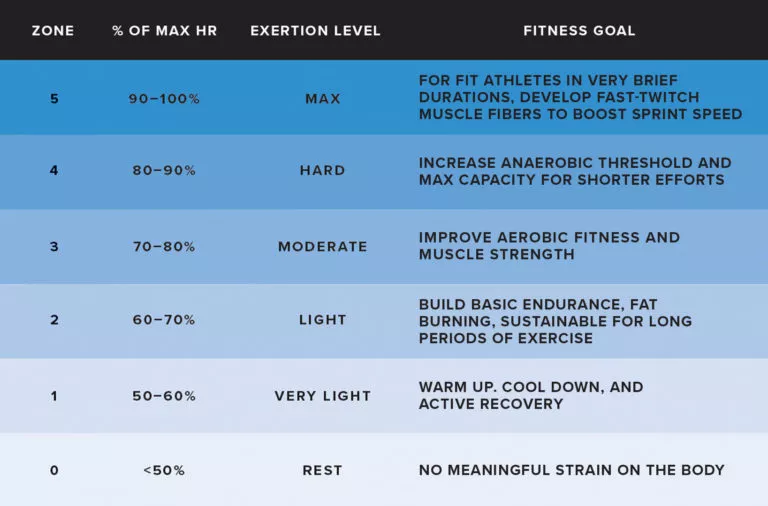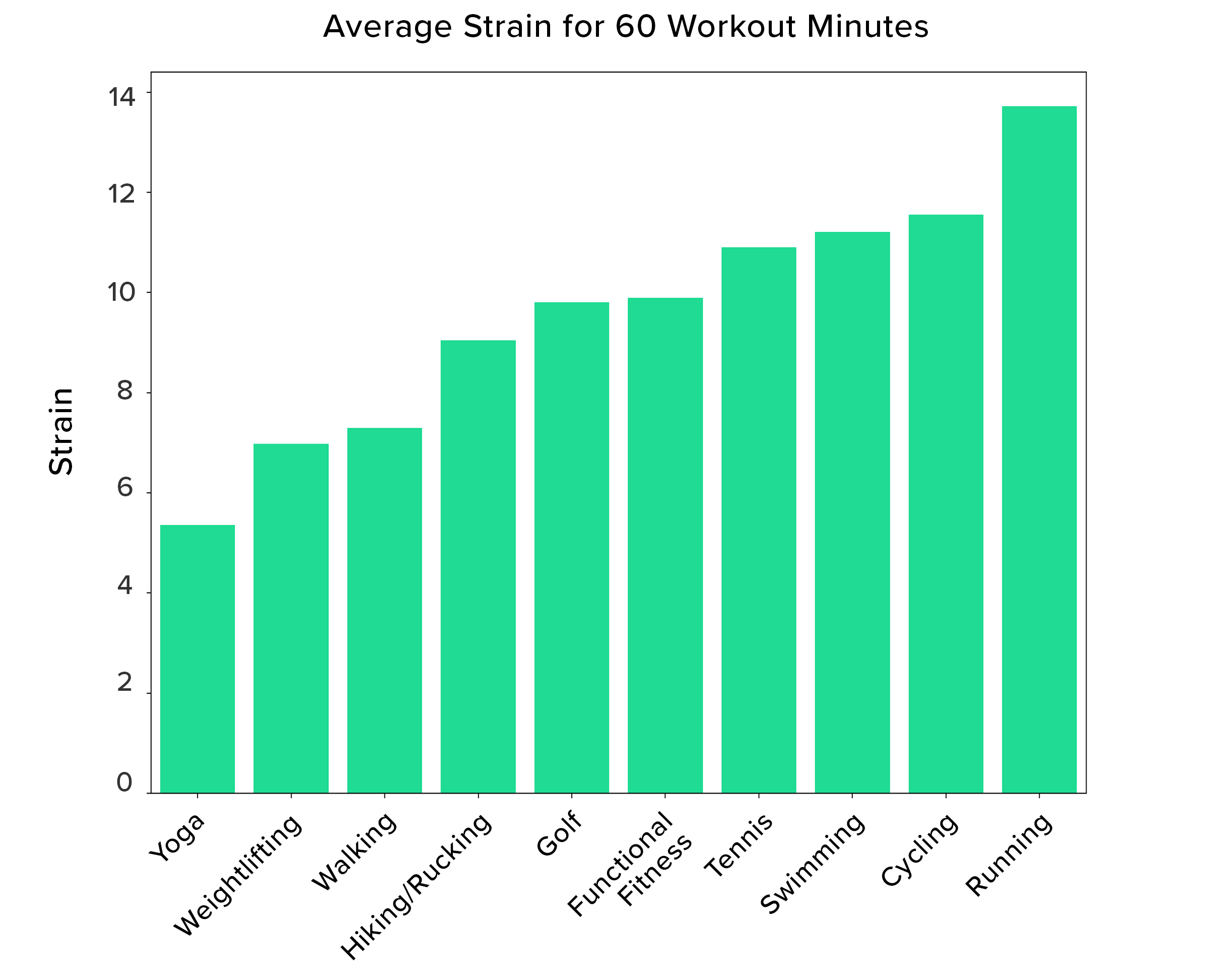Whoop Strain – An Explainer
Whoop scores your efforts numerically.
So you might score a 15 and then a 3 later in the day with a different workout. Confusingly, 15+3 doesn’t equal a score of 18 for the day and even if it did that is still short of a maximum score of 21.
Must Read: The Whoop 4 Strap Review
The Whoop Scale: 21 is good. Very Good
It’s hard to get a maximal score of 21 on the Whoop strain scale.
It’s a measure of how high your heart rate is and for how long you maintained it. It’s not measured on a simple, linear scale and it’s not additive. Thus 15+3 is probably either 15 or 16 and certainly not 18 in WhoopWorld.
Here’s what your Whoop strain score means in a little more detail
- LIGHT (0-9): Minimal stress put on the body, room for active recovery
- MODERATE (10-13): Moderate stress on the body, generally good for maintaining fitness
- HIGH (14-17): Increased stress and activity level, ideal for making fitness gains when training
- ALL OUT (18-21): Significant stress, often overreaching, likely very difficult to recover from the next day
Every major sports data platform has some similar way of accounting for your cardiovascular exertion except none has 21 as a maximum.
Q: Does that matter?
A: No, of course not. You’ll probably never legitimately score a 21 in any case.
Garmin has non-linear Training Effect (TE) scores out of 5. Then they split the Training Effect into Anaerobic TE and Aerobic TE, which don’t then add back up to the original 5. Does that matter? No.
Q: Why does Whoop measure strain from your heart rate? Surely it’s easier to measure steps?
A: Yes it’s easier to measure a raw number of steps but how would you measure an intense step vs a non-intense step? And what about a medium-intensity step, what does that mean? You could somehow measure the impact but that would be different on grass vs tarmac. Whoop’s heart rate calculations work and there’s science supporting it going WAY back to the 1960s.
What Causes Strain? How Does WHOOP Calculate It?
Any muscular activity causes strain on those muscles. Your heart rate is a ‘proxy’ for the holistic cardiovascular strain on your body ie it’s not the strain on the heart muscle we are seeking to measure but rather the strain of, say, your quads whilst cycling.
We can easily measure the time at which your heart rate is at a certain level and also relatively easily measure the heart rate itself. However, as an endurance athlete, my 130bpm means something very different to your 130bpm heart rate, so Whoop uses relatively standard methods to place that 130bpm in the context of our individual maximal heart rate to add meaning to the HR level it records. You might be familiar with broadly accepted concepts like heart rate training zones that add more context.
Whoop’s precise calculation is not known but in essence, it will be: time in zone multiplied by duration – with a higher weighting given to a higher zone. An example of a similar calculation for TRIMP is here.

But it’s not so simple. Your average commute or argument with your boss or excitement whilst watching a horror film might each add strain. Thus Whoop identifies DAY STRAIN and WORKOUT STRAIN.
I’m not sure if Whoop applies the same algorithm to strain accumulated outside of exercise. I once measured 24 hours of ‘strain’ using a different method at a time when I was training hard. The non-workout strain was trivial to the point of irrelevance and in my case, at that time of my life, it wasn’t worth measuring. We’re all different.
Sport Type & The Impact On Strain
Unsurprisingly Whoop users record the highest one-hour strain results when running as this chart shows.

Running is load-bearing, it uses the big muscle groups and often has no rest periods. It’s hard.
Q: If I cycle hard one day and swim the next, does the strain of one sport affect the other?
A: Yes is the simple answer. However, I don’t think any sports platform has yet properly quantified for consumers how to correctly add strain together from one sport to the next. I mentioned only recently the steps Xert is slowly taking to solve this conundrum. However, Whoop absolutely will correctly assess your recovery from every and any sport.
Weight a minute.
Q: Even for lifting weights?
A: Yep. Whoop will correctly tell you your recovery. However, the accumulation of strain from strength workouts is not properly accounted for by Whoop as Whoop uses metabolic strain and pure strength training (weights) is not metabolically hard, although it clearly is hard in a different sense. You will find that strength workouts impact the strain scores of other activities and certainly that they will affect your readiness scores in Whoop. Whoop recently acquired PUSH and we shall hopefully see the latter’s Velocity Based Training methods incorporated into Whoop’s algorithms so that strength training is better accounted for. No other platform properly accounts for this type of strain AFAIK.
Strain Coaching & Strain Assessment
Q: Is my strain normal?
A: Whoop says that their average user has an average daily strain score of between 10 and 11. If you want to perform averagely just aim for that every day 😉
The point here is that most of us have no idea what the correct level of strain is. Generic training plans from the web, even the good ones, will not account for your personalised daily recovery levels. With Whoop you have a smart coach that knows what strain is best for you today.
One of the downsides of a band is that you cannot get live feedback on your strain during a workout unless you carry the app. Sometimes you might under- or over-shoot your target but you can see from your weekly report how optimal your training has been.
However, the strain coach is geared toward ensuring you maintain your fitness. So you should be looking to intentionally overshoot the strain 2-3 days a week and pay attention to what Whoop tells you to do on the recovery days.
Remember: High strain will not make you better...it’s the good recovery afterwards where your body adapts and improves.
Any Questions? Try These…
Here are some questions and answers that explain the nuances of strain.
Q: Does Whoop use HRV used to calculate strain?
A: No. It is effectively impossible to use HRV to calculate strain in any meaningful way at present. Any company that claims to do this for consumers is probably making invalid assumptions. Whoop absolutely does use HRV to assess recovery and that is a valid approach.
Q: Does strain equate to calories
A: No they are accumulated on different scales.
Q: How many high strain days a week should I have?
A: If you are asking that question it should be 1-3 days. Highly trained athletes may well be able to tolerate more strain for example triathletes may have a hard running day followed by a hard bike day. Elite endurance athletes will probably spend 80% of their training time doing EASY exercises. Amateurs train moderately a lot of the time and fail to progress beyond the plateau they soon reach.
Q: Are strain scores additive
A: No.
Q: Are Whoop’s algorithms a modified version of TRIMP?
A: One part of its algorithm is like TRIMP. However, Whoop metrics are contextualised within your normal ranges of performance/recovery.
Q: Are Whoop’s algorithms personalised
A: Yes there is a high degree of personalisation both for the strain calculation and from the assessment of its context to you.
Q: Is the strain score affected by sensor accuracy
A: Obviously that is the case. My guess would be that even a 5% inaccuracy would not materially affect the validity of the feedback you are given. Wearing Whoop on the bicep is a very accurate way to collect good HR data. Every optical HR sensor from every manufacturer will be inaccurate on the wrist in various circumstances – it’s the worst place to measure heart rate! It’s up to you what degree of accuracy you prefer.
Q: Why is strain registered before I start my workout?
A: Whoop separates out day strain from workout strain. Day strain is less significant and starts to accumulate from midnight.
Q: Can I lower my strain during the day
A: No. The strain calculation starts at midnight. You can control your recovery from the accumulated strain eg by sleeping.
Q: How hard is 21 to get to?
A: You’ll know when you get there. If you often get there relatively easily then your HRmax setting is wrong.
Q: If I get fitter will my strain scores go up?
A: Yes they might do as you will be able to tolerate harder exercise. However, against that will be the fact that your body gets better so it can go faster on the same amount of strain that it did when you were less fit. So the purpose of training is to get fitter/faster/better and not to get ever higher strain scores per se.
Q: What factors affect strain?
A: Your entire lifestyle will affect your daily strain.
Q: What factors make my strain and somebody else’s different?
A: Again it’s your lifestyle and history. The biggest factor will be the amount of exercise you perform. If you and a friend perform identical workouts next to each other but one of you has a higher score then the one with the lower strain is ‘fitter’ on the day. Perhaps the other person is fitter in reality but had a very hard workout the previous day. It’s complicated and these factors also come into play diet, hydration, supplementation, mechanical efficiency, illness, stress and more besides.




Has there been any word on integrating the Push Band algos?
nada sorry
https://www.whoop.com/thelocker/acquires-push-velocity-based-training-solution/
yes, i link to this above: https://the5krunner.com/2021/09/03/whoop-acquires-push/